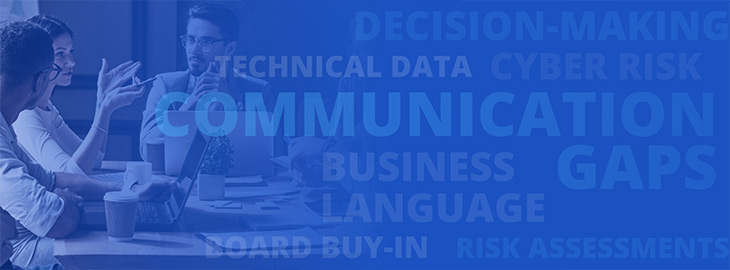
Effective communication is at the heart of any successful organization. It ensures that information is clearly conveyed, understood and acted on. But sometimes, despite our best intentions, there can be a gap between what we say and what the other person hears.
The result? Confusion, misunderstandings and missed opportunities.
When it comes to talking about cyber risk, you can bridge this communication gap by translating technical, information security data into the language of business impact. Start with these 3 steps.
The Illusion of Proper Cyber Risk Communication
In March 2023, RiskOptics surveyed 261 information security and governance, risk and compliance (GRC) professionals across different sectors in the United States. We reported the results in the 2023 RiskOptics Cyber Risk Viewpoints Report.
One of the things that caught my attention is that there seems to be a disconnect between how cyber risk is communicated and how it’s actually understood.
Only half of the survey respondents felt extremely confident that organizational leaders tie cyber risk to strategic planning. When we dove a little deeper, we found viewpoints varied widely by role: 56% of C-Suite respondents and 63% of SVPs felt extremely confident in leaders using cyber risk for strategic planning, compared to only 37% of managers and 44% of directors.
The Missing Link: Business Context
When talking to their board and executive leadership, most survey respondents reported that they’re using risk assessments and risk scores to communicate the impact on their organization. However, leadership may not find this technical information helpful – especially without context around how it impacts their specific business initiatives.
To bridge the communication gap, try placing risk in a business context. There’s been some movement to require at least one board member to be cybersecurity savvy. Still, traditionally, board members usually aren’t familiar with the intricacies of IT, infosec, compliance and risk.
What they want is to understand the value of their investments in business terms:
- Why invest?
- Where is the money going?
- How are these solutions protecting the organization?
- And what will happen if they don’t invest?
If your communication focuses solely on the technical aspects of cyber risk without connecting them to tangible business outcomes, key information can get lost in translation. And leadership may be less effective at incorporating that information into strategic decisions.
How to Translate Cyber Risk into Business Terms
Effective cyber risk communication involves translating technical terms and concepts into a language that resonates with business leaders. It takes a thoughtful approach to ensure that risks are articulated in terms of their potential impact on critical business objectives, such as revenue, customer satisfaction, regulatory compliance and your company’s reputation.
For example, if you have a technical vulnerability that’s impacting a system, frame the conversation with your leadership around what that system does for your business. Discuss the potential financial loss that could result from a breach or damage to your reputation.
By connecting cyber risk directly to the business impact, you are enabling leadership to take appropriate action and make informed decisions that align with the organization’s overall goals.

3 Steps to Bridge Cyber Risk Communication Gaps
One way to bridge cyber risk communication gaps is to foster a culture that encourages effective risk communication.
Here are 3 steps to consider:
Step #1: Provide Context
Rather than presenting risk scores or other technical information in isolation, emphasize how risks may impact specific business initiatives, financial performance, customer satisfaction or regulatory compliance. This approach helps decision-makers understand the relationship between cyber risk and overall business objectives.
Step #2: Tailor Your Communication
Stakeholders have different concerns and levels of expertise. Adjust your communication style, language and medium to ensure the information you’re communicating is accessible and meaningful to your audience. Increase the clarity and comprehension of your message by using clear examples, storytelling and graphics to communicate complex ideas.
Step #3 Foster Collaboration
Effective communication is a two-way street. Encourage collaboration between IT professionals and business leaders to ensure that both parties have a mutual understanding of risks and their potential impact. This collaborative approach can help identify blind spots and ensure that no critical information is lost in translation.
By bridging cyber risk communication gaps, organizational leaders can make data-driven, risk-informed decisions that align with strategic business objectives and ultimately lead to improved outcomes.
Translate Your Cyber Risk — Automatically
Effective cyber risk communication involves translating technical risk information into tangible business impact using a shared language so that stakeholders are better informed and can collaborate easily with information security professionals.
However, translating cyber risk into business terms doesn’t have to create extra work for your team. For example, the ZenGRC gives you a unified, real-time view of risk and compliance — framed around your business priorities — so you have the contextual insight needed to easily and clearly communicate with key stakeholders.
That way, they can make smart, strategic decisions to protect your enterprise, systems and data. And, most importantly, earn the trust of your customers, partners and employees.
Discover the power of ZenGRC! Schedule your FREE demo today.




